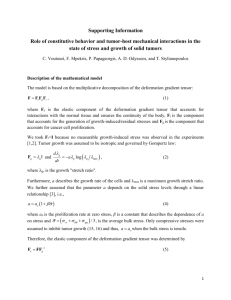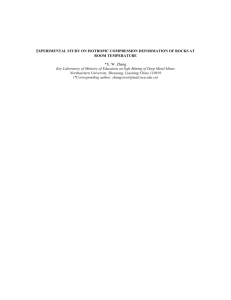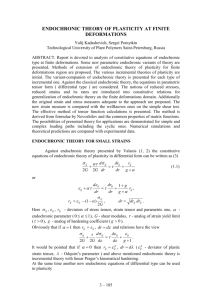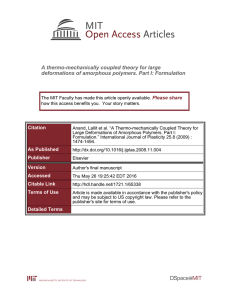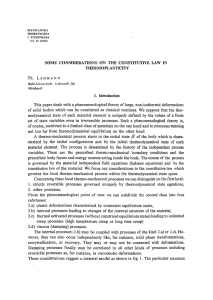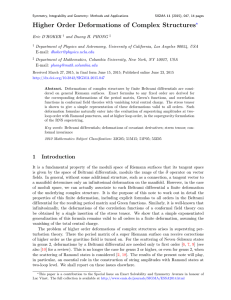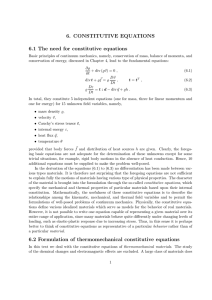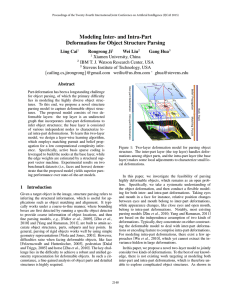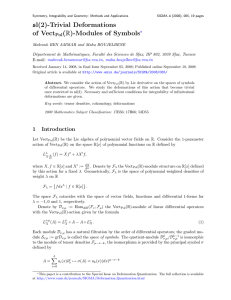Linear Constitutive Relations in Isotropic Finite Elasticity 243 R.C. BATRA
advertisement
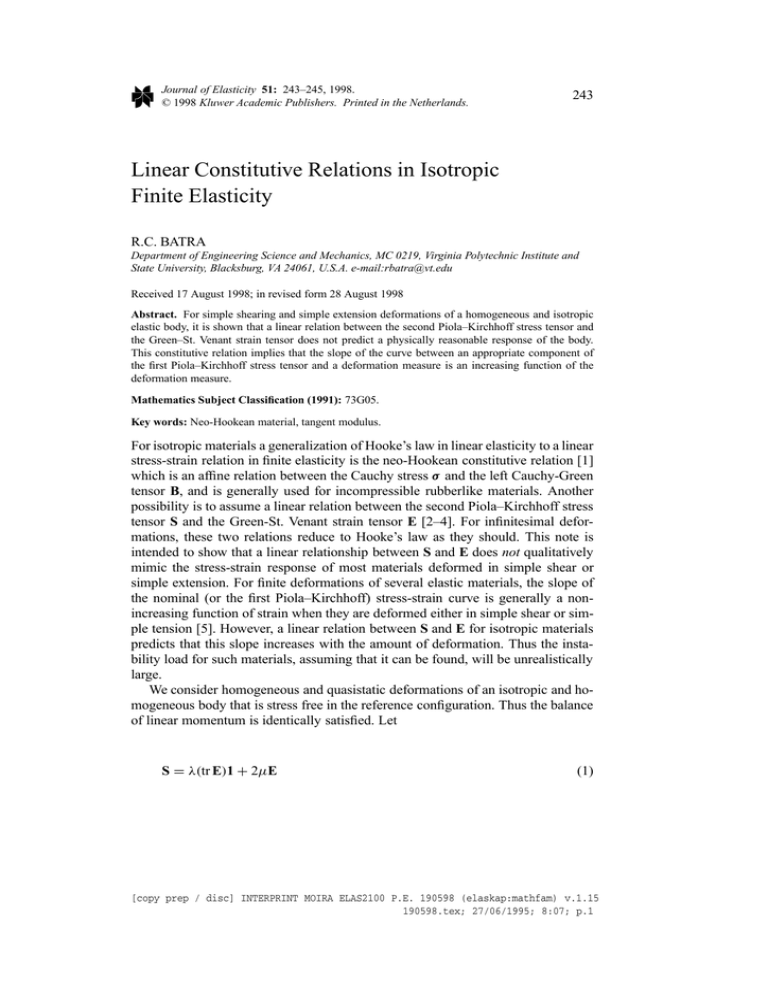
Journal of Elasticity 51: 243–245, 1998. © 1998 Kluwer Academic Publishers. Printed in the Netherlands. 243 Linear Constitutive Relations in Isotropic Finite Elasticity R.C. BATRA Department of Engineering Science and Mechanics, MC 0219, Virginia Polytechnic Institute and State University, Blacksburg, VA 24061, U.S.A. e-mail:rbatra@vt.edu Received 17 August 1998; in revised form 28 August 1998 Abstract. For simple shearing and simple extension deformations of a homogeneous and isotropic elastic body, it is shown that a linear relation between the second Piola–Kirchhoff stress tensor and the Green–St. Venant strain tensor does not predict a physically reasonable response of the body. This constitutive relation implies that the slope of the curve between an appropriate component of the first Piola–Kirchhoff stress tensor and a deformation measure is an increasing function of the deformation measure. Mathematics Subject Classification (1991): 73G05. Key words: Neo-Hookean material, tangent modulus. For isotropic materials a generalization of Hooke’s law in linear elasticity to a linear stress-strain relation in finite elasticity is the neo-Hookean constitutive relation [1] which is an affine relation between the Cauchy stress σ and the left Cauchy-Green tensor B, and is generally used for incompressible rubberlike materials. Another possibility is to assume a linear relation between the second Piola–Kirchhoff stress tensor S and the Green-St. Venant strain tensor E [2–4]. For infinitesimal deformations, these two relations reduce to Hooke’s law as they should. This note is intended to show that a linear relationship between S and E does not qualitatively mimic the stress-strain response of most materials deformed in simple shear or simple extension. For finite deformations of several elastic materials, the slope of the nominal (or the first Piola–Kirchhoff) stress-strain curve is generally a nonincreasing function of strain when they are deformed either in simple shear or simple tension [5]. However, a linear relation between S and E for isotropic materials predicts that this slope increases with the amount of deformation. Thus the instability load for such materials, assuming that it can be found, will be unrealistically large. We consider homogeneous and quasistatic deformations of an isotropic and homogeneous body that is stress free in the reference configuration. Thus the balance of linear momentum is identically satisfied. Let S = λ(tr E)1 + 2µE (1) [copy prep / disc] INTERPRINT MOIRA ELAS2100 P.E. 190598 (elaskap:mathfam) v.1.15 190598.tex; 27/06/1995; 8:07; p.1 244 R.C. BATRA represent a linear constitutive relation for the elastic body. In order for (1) to reduce to Hooke’s law for infinitesimal deformations, λ and µ must equal the Lamé constants and are taken to satisfy µ > 0, λ + (2/3)µ > 0. In rectangular Cartesian coordinates, a simple shearing deformation is given by x1 = X1 + kX2 , x2 = X2 , x3 = X3 , (2) where x gives the position vector in the deformed configuration of the material particle that occupied place X in the reference configuration, and k is a measure of the shear strain. From (1), (2) and σ = FSFT /J, T = FS, (3) where T is the first Piola–Kirchhoff stress tensor, F the deformation gradient, and J = det F, we obtain T12 = µk + [ 12 λ + µ]k 3 . (4) d2 T12 = 3(λ + 2µ)k > 0 dk 2 (5) Thus and the tangent modulus dT12 /dk is an increasing function of k. For general deformations, equations (1), (3) and the Hamilton–Cayley theorem [1] imply that 1 µ σ = − I I 1 + [( 12 λ + µ)(I − 3) + 2µ]B + µJ B−1 , J J (6) where B = FFT , I = tr B and I I = (l 2 − tr B2 )/2. Thus the relation between σ and B corresponding to (1) is nonlinear. We now study simple extension, given by x1 = αX1 , x2 = βX2 , x3 = βX3 , (7) of a prismatic body; α and β are constants in (7). We assume that the deformation (7) is produced by surface tractions parallel to the x1 -axis, applied only on the end faces of the prismatic body. Equations (1), (7), the requirement that the mantle of the prismatic body be traction free, and (3) give T11 = µ 3λ + 2µ α(α 2 − 1). 2(λ + µ) (8) Thus 3λ + 2µ d2 T11 = 3µ α>0 dα 2 (λ + µ) (9) 190598.tex; 27/06/1995; 8:07; p.2 LINEAR CONSTITUTIVE RELATIONS IN ISOTROPIC FINITE ELASTICITY 245 and the tangent modulus is an increasing function of α. The neo-Hookean constitutive relation σ = 12 λ(tr B − 3)1 + µ(B − 1) (10) gives T12 = µk for simple shearing deformations (2) and T11 = 3λ + 2µ 2(λ + µ) µ2 (α 2 − 1)(1 − λ(α 2 − 3)/2µ), λ+µ (11) for simple extension (7) which are reasonable. From (11) one can conclude that the tangent modulus d T11 /dα is positive at α = 1, equals zero for α 2 = (µ + 2λ)/λ and is negative for α 2 > (µ + 2λ)/λ. However, the corresponding relation S = J [(λ tr E − µ)(1 + 2E)−1 + µ1], (12) between S and E is more involved, and is nonlinear. In conclusion, the linear relation between S and E does not mimic the nominal stress vs. strain curve experimentally observed for a large class of isotropic elastic materials. Acknowledgement S.S. Vel’s constructive comments on an earlier draft of this note are appreciated. References 1. 2. 3. 4. 5. C.A. Truesdell and W. Noll. The nonlinear field theories of mechanics. In: S. Flügge (ed.), Handbuch der Physik, III/3. Springer-Verlag, Berlin/Heidelberg/New York (1965). M.B. Rubin. A thermoelastic-viscoplastic model with a rate-dependent yield strength. J. Appl. Mechs. 49 (1982) 305–311. R.C. Batra and X.Q. Liang. Finite dynamic deformations of smart structures. Comp. Mechs. 20 (1997) 427–438. J. Zhai and M. Zhou. Finite element analysis of micromechanical failure modes in heterogeneous solids (pending publication). J.F. Bell. The experimental foundation of solid mechanics. In: C. Truesdell (ed.), Handbuch der Physik, VIa/1. Springer-Verlag, Berlin/Heidelberg/New York (1973). 190598.tex; 27/06/1995; 8:07; p.3
